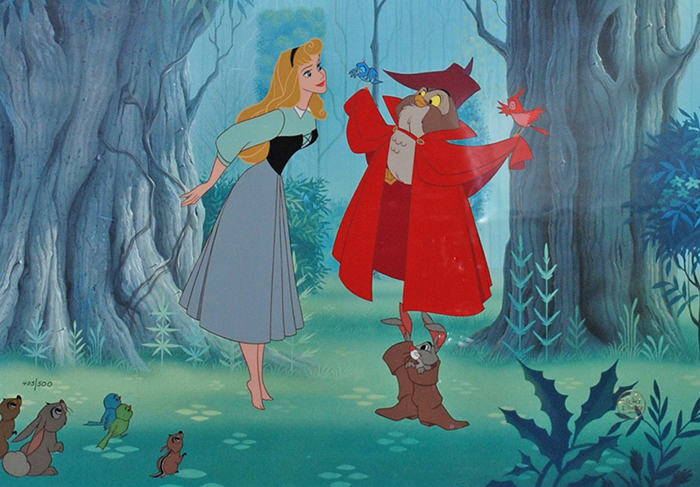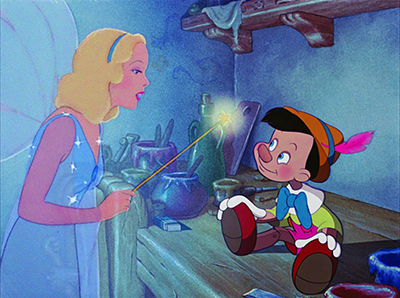Maybe it was just a break from our usual “convos” about sports or music, but there came a day when Zack and I got to considering the canon of Disney animated films. What were our favorites? Favorite characters? Best music?
From the post in 2006, “I rattle off my top 3, thinking mainly music: Beauty and the Beast, Little Mermaid, Sleeping Beauty… He counters: Jungle Book, Aladdin, and The Lion King… although the music is key for me, Zack feels it’s secondary… Then he tosses down the gauntlet to me, “and my Parrot (Aladdin) trumps your Crab (Little Mermaid)!”
Then I upped the ante: “In an unprecedented move I have decided to list my 10 favorite Disney’s in a specific order (as opposed to an alphabetic listing of the Top Ten)… each film listed is accompanied with a few articulate observations and enlightening details. Bear in mind, I’m not a movie critic… and who knows, next year I might change my mind, and besides, you can never tell what new magic Disney may produce”.
OK. I have seen any number of Disney films over the last 13 years, both in the theatre and on DVD; and after reading through my list from 2006, I thought that a repositioning of my Top Ten Favorites was in order. Yes, changes abound. Five titles have been dropped, and there has been some internal shuffling on the remaining five.
My List from 2006
- Beauty and the Beast
- Sleeping Beauty
- The Little Mermaid
- Lion King
- Aladdin
- Winnie the Pooh
- The Jungle Book
- Fantasia
- Pinocchio
- Robin Hood
My List, Updated 2019
-
Beauty & the Beast (1991)

I think I have seen this film more times than Casablanca, and that alone is reason to secure this Disney in my top spot. From the opening sequence when David Ogden Stiers intones the “backfill” to the story, to the ending credits when Celine Dion and Peabo Bryson sing their version of the title track, I am in my glory.
Above all, I love the music… and in particular the staging of the initial musical number with Belle walking into town… interacting with the locals. And then, more spectacular, the waltz scene has a “state of the art” 3D quality and plays to Angela Lansbury’s more vulnerable version of the title track… a version I actually prefer to the ending track. There is more, also memorable is the ensemble rendition of “Something There” which is well presented with the music simply backing the sequence when Belle’s tenderness for the Beast emerges.
Other Disney story lines maybe superior… but this is simply my favorite… and when I need 40 winks, I will seek out a couch, get comfy and wait for the music to ease me… tale as old as time…
-
Sleeping Beauty (1959)

When “Disney naps” became a feature of my life, this film got its major boost into a top 10 slot. Unlike other Disney’s that feature original songs and scoring (songs, by the by, that often are Academy Award winners), Sleeping Beauty’s score is predominately adapted from Tchaikovsky’s Ballet Suite of the same name. And I love Tchaikovsky’s Nutcracker, Swan Lake, and Sleeping Beauty. I have never tired of their main themes.
And as much as I love the music, Sleeping Beauty features one of my favorite “bad guys” (but in this case the “bad guy” is a lady): the powerful sorceress Maleficent.
And for humor, I love the scene in the cottage when Fauna, Flora, and Merryweather get busy making a cake and special dress for the Princess Aurora’s Birthday.
But when all is said and done… for me, it’s about the music.
-
Tangled (2010)

I love the color palette used in this film. Softer tones… more like pastel rather than oil. This effect is well seen in the outdoor settings around Rapunzel’s Tower, as well as in the dance scene in the town. The story line is one of Disney’s best, supported with very clever dialogue. Funny, rich with sarcasm and a touch of smart-ass.
The assembled thugs at the Snuggly Duckling Tavern are brilliantly drawn, and are turned into a rogue’s band of “merry men” who contribute to the developing mayhem in the plot.
I never tire of the scene when Flynn first meets the frying-pan-wielding Rapunzel in the tower. It is hysterical, loaded with classic rapid fire slapstick sequences.
But the prize in this film has to go Mother Gothel, as evil a looking crone if ever there was one, but who we see predominantly as a rather chic-looking-diva-Cher wannabe. A splendid “bad guy” in the best of Disney tradition. She has show piece songs, and wonderful lines: “Rapunzel, look in that mirror. Do you know what I see? I see a strong, confident, beautiful young lady…. Oh look, you’re here too!”
-
Alice in Wonderland (1951)
 I don’t recall seeing this film in a theatrical release. And truth be told, I only picked it up in the DVD a couple of years ago. In short time it has become one of my Disney favorites. This movie has more songs and characters than any other Disney animated film. And while I usually place highest stock in music, my love of this film is based on the “hodge-podge” of characters that populate the film’s vignettes.
I don’t recall seeing this film in a theatrical release. And truth be told, I only picked it up in the DVD a couple of years ago. In short time it has become one of my Disney favorites. This movie has more songs and characters than any other Disney animated film. And while I usually place highest stock in music, my love of this film is based on the “hodge-podge” of characters that populate the film’s vignettes.Each sequence has its featured performer. There is a talking door knob, the Mad Hatter (superbly voiced by Ed Wynn), the Cheshire Cat (Sterling Holloway of Winnie the Pooh fame), the March Hare, the oyster-eating Walrus, the White Rabbit and the highly irritable Queen of Hearts.
But my favorite character is the hookah-smoking caterpillar. Although the film offers an excellent collection of unconnected scenes, the caterpillar scene is my favorite. The caterpillar draws a puff from his hookah, sends a ring of smoke in the air, and corrects Alice’s recitation, “That is not spoken correctically. It goes: How doth the little crocodile improve his shining tail. And pour the waters of the Nile, on every golden scale. How cheerfully he seems to grin, how neatly spreads his claws. And welcomes little fishes in with gently smiling jaws.”
-
The Little Mermaid (1989)

I love the opening sequence showing the wooden ship pitching in the rolling sea… we listen to Fathoms Below and then follow the path of a fish that escaped from the deck of the ship to the undersea world of Triton, King of the Mer-people, Ariel his daughter, and a terrific villainess, Ursula the Sea Witch (wonderfully drawn with a fabulous voice over by Pat Carroll).
But the character who steals the show is Sebastian the Crab. His lilting “island accent” sets the tropical tone of the film… and I don’t whether Samuel E. Wright, Sebastian’s voice, sounds like that naturally or if the accent is staged. No matter, he is a perfect and he leads two songs that both get nominations for the Academy’s Best Song Award: Kiss the Girl and Under the Sea… which is why the “crab” takes Aladdin’s “parrot” hands down.
-
The Jungle Book (1967)

This Disney has a real good story line and another all star cast of voices. My favorite voice is George Sanders as the Tiger Shere Khan. I have a real soft spot for Sanders… his role as the supreme cad Addison DeWitt in All About Eve combined the elegant sophisticate with the low gutter snipe. In Shere Khan he brings that lofty patrician Lloyd Harbor tone combined with the menacing sense of evil.
Then there is Sterling Holloway, one of my Disney favorites (Winnie the Pooh and the Cheshire Cat), this time in the role of Kaa the Snake. Phil Harris as Baloo the Bear is lovable and hugable… I just have a hard time squaring the Disney image with his public persona of the hard boozing, heavy smoking reprobate of Vegas lounge acts. Louie Prima as King Louis is top stuff, too. As is Sebastian Cabot’s Bagheera.
But my favorite character is Pat O’Malley’s Colonel Hathi of the Elephant Dawn Patrol. He executes a near perfect parody of the aging British Officer serving out his time is some Colonial backwater, reliving memories and glories of “Chinese” Gordon and Khartoum.
-
Peter Pan (1953)

This is not only a terrific Disney “classic” film, Peter Pan is also a terrific attraction at Disney World! And what’s the best part of the ride? It’s when your pirate ship flies above the City of London and circles Big Ben. The illusion is perfect! A superb rendition of the scene from the film.
Yes, Peter Pan has an engaging story line, but I watch this film as often as I do because of Hans Conried! He, the voice of both Mr. Darling and Captain Hook. If there was a contest for Best Disney Voice characterization, Hans Conried would be a finalist (and favored to win!).
Captain Hook is Disney’s most lovable villain. More bumbling than truly evil, yet skilled in the art of intrigue. And besides, he was a snappy dresser!
-
Moana (2016)

Great characters, good story, funny lines, a tropical beach setting and Lin-Manuel Miranda’s music. Need I say more? This is the most recent Disney release to make my Top Ten!
Once again we meet an outrageous scene stealer: “Do you know who Maui is? Only the greatest demi-god of all the Pacific Islands, with his magical fish hook he slowed down the sun, pulled islands out of the sea, battled monsters! And I should know, because I’m Maui.”
Maui, oversized and with a penchant for perfectly timed side-splitting sarcasm! And he has a show-stopping tune “Thank You” that dips into some clever rap:
Well, come to think of it, kid, honestly I can go on and on
I can explain every natural phenomenon
The tide, the grass, the ground, oh
That was Maui just messing aroundI killed an eel
I buried its guts
Sprouted a tree, now you got coconuts
What’s the lesson?
What is the take-away?
Don’t mess with Maui when he’s on the break-awayBut by far the best and most clever song (“Shiny”) is reserved for the giant crab Tamatoa. And it certainly sounds like Lin-Manuel Miranda was channeling David Bowie with the tune.
Did your granny say listen to your heart
Be who you are on the inside
I need three words to tear her argument apart
Your granny lied!I’d rather be shiny
Like a treasure from a sunken pirate wreck
Scrub the deck and make it look
ShinyShiny indeed. And this film shines on all levels. From charm, to funny, to poignant, to scary and back again!
-
Pinocchio (1940)

This is one of my favorite Disney story lines, and more than anything I love how the characters are drawn… I don’t like cats but Figaro is a cat you want to cuddle, only Disney artists could create a flirt in the form of Cleo the goldfish, and Monstro as the whale frightened me when I was a kid… but my favorites in the cast were Stromboli the “impresario” and Lampwick the juvenile delinquent.
The opening scenes in Geppetto’s work shop remains one of my favorite sequences. Jiminy warming his tush by the log fire, the clocks, and the merry dancing after the Blue Fairy converts the lifeless marionette into a wooden boy.
And yes, I have a soft spot for Jiminy Cricket, too. You got to love “small folk”. And his rendition of “When You Wish Upon a Star” garnered an Academy Award for the Best Song.
n.b. The voice for Honest John’s side kick Gideon is Mel Blanc — he of Warner Bros. cartoon fame.
-
Hercules (1997)

This is the long shot, or the surprise from left field, or I have only seen it fully thru once! Then, you may ask, how did this happen? If blame is to be cast, look to Zack. Hercules was completely off my radar. I didn’t see the theatrical release, nor did I see it in DVD. Until. Until Zack told me that the drawing of Hades, and his voice characterization (James Woods), was beyond Mars.
Zack underprojected! I loved the film. And I have an interest in antiquity that touches on Greek mythology. Disney spins the classical muses into a Motown singing group. Thumbs up on that!
But that’s not why Zack pointed me to this film. It was James Woods’ portrayal of Hades.
Hard to believe that based off of one viewing of this film, it would make my Top Ten. That speaks to how fabulous Hades is!
And it’s not only me who thinks highly of Hades —
“The role of Hades is one of James Woods’ all-time favorite characters. So much so, any time Disney needs him to reprise the character for any cartoon show and video game, such as Hercules: The Series or Kingdom Hearts, he has agreed to do so. When this film was about to go over-budget, he offered to refund his salary and finish the film for free. Disney decided against this, and finished the film anyway.”
The Afterword
Fun for me to review my choices from 13 years ago. As I predicted in my original post, things can change. What we love today, we might not love as much tomorrow. And who knows when something new will catch our eye and heart. From my original Top Ten, the loss that troubles me most is “Fantasia.” I love the music in the film so much, that I can enjoy the variety of pieces with my eyes closed. Yet the animation adds a special dimension to the music that should never be kicked to the curb.
Maybe the problem is limiting what you love to a Top Ten format?
The Lion King and Aladdin are both missing here. So is Lilo and Stich, and Frozen. And more can be mentioned.
Sometimes you just have to go thru the discipline of picking “win-place-and-show”. Which is what I have done… just expanded it to: Win, Place, Show… yadda, dadda, dah — to ten.


